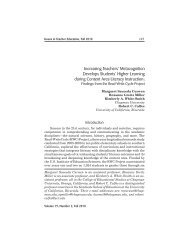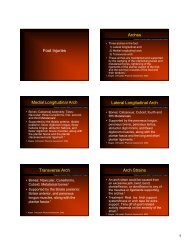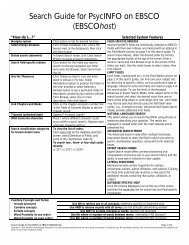e-Research: A Journal of Undergraduate Work - Chapman University
e-Research: A Journal of Undergraduate Work - Chapman University
e-Research: A Journal of Undergraduate Work - Chapman University
You also want an ePaper? Increase the reach of your titles
YUMPU automatically turns print PDFs into web optimized ePapers that Google loves.
A. Cyr, M. Weitzman<br />
ICP0 is necessary for its function. Viral proteins interact with cellular proteins to regulate gene expression. Rather<br />
than binding to DNA directly, ICP0 acts by ubiquitin-proteasome pathways <strong>of</strong> cellular protein and nuclear domain<br />
structure degradation (Everett, 2000).<br />
Once primary infection is established, the host cell recognizes the viral genome as DNA damage, thus a network <strong>of</strong><br />
signaling pathways are coordinated by the cells DNA repair machinery (Lilley et al, 2010). Several factors are sent<br />
by the cell to respond to the invasive viral genome as recognized by the cell. A series <strong>of</strong> phosphorylations produce<br />
irradiation-induced foci (IRIF)-like subnuclear structures near the incoming viral genome. IRIF organization involved<br />
in marking sites <strong>of</strong> cellular DNA damage is still being studied (Huen and Chen, 2008). A mediator protein, Mdc1<br />
(Mediator <strong>of</strong> DNA damage check point protein 1), interacts with gH2AX and ATM (Lou et al, 2006).<br />
Two cellular ubiquitin ligases, RNF8 and RNF168, are important in the formation <strong>of</strong> IRIF (Huen et al. 2007). RNF8<br />
binds to phosphorylated Mdc1 and ubiquinates H2A and H2AX histones (Huen et al 2007). The second ubiquitin<br />
ligase, RNF168, reinforces this mechanism by further modifying ubiquinated histones (Doil et al, 2009; Stewart et<br />
al, 2009). These mechanisms coordinate the recruitment <strong>of</strong> DNA repair proteins to sites <strong>of</strong> IRIF by proteins with<br />
ubiquitin interacting motifs and promoting chromatin restructuring (Huen et Chen, 2008). The parallels between<br />
IRIF and IRIF-like sub nuclear structures formed near incoming viral genome are a research focus.<br />
In a previous study to determine a link between viral reactivation and damage signaling, ICP0 was found to<br />
degrade RNF8 and RNF168 (Lilley et al. 2010). Less DNA repair proteins accumulate at sites <strong>of</strong> DNA damage once<br />
ICP0 induces the degradation <strong>of</strong> RNF8 and RNF168 (Lilley et al. 2010). Proteasome-mediated degradation <strong>of</strong> RNF8<br />
and RNF168 is ICP0-dependent (Lilley et al. 2010). In the absence <strong>of</strong> ICP0 (mutated viral genomes deleted for ICP0),<br />
RNF8 and RNF168 are not degraded. RNF8 and RNF168 interact with ubiquitin to target histone H2A and mark<br />
regions <strong>of</strong> DNA damage. Histone H2A directs DNA repair proteins to these sites. In the absence <strong>of</strong> ubiquinated<br />
H2A, the accumulation <strong>of</strong> repair proteins is hindered and viral genes are expressed. Degradation <strong>of</strong> RNF8 and<br />
RNF168 is responsible for the loss <strong>of</strong> H2A ubiquitination and disruption <strong>of</strong> IRIF in the presence <strong>of</strong> ICP0 (Lilley et al.<br />
2010).<br />
RNF168 is involved in mediating the recruitment <strong>of</strong> DNA repair proteins. RNF168 includes a RING finger motif and<br />
two motifs interacting with ubiquitin (MIUs) (amino acids 168-191 and 439-571). The RING finger motif (amino<br />
acids 15-58) <strong>of</strong> RNF168 interacts with other cellular factors to add ubiquitin onto target proteins. Mapping the<br />
regions required for RNF168 degradation by ICP0 gene expression may indicate a more precise location and a<br />
specific motif in RNF168.<br />
Figure 1: Schematic image <strong>of</strong> RNF168 containing a RING finger motif, MIU1, and MIU2.<br />
MATERIALS AND METHODS<br />
Cloning<br />
PCR<br />
Used Polymerase Chain Reaction for amplification <strong>of</strong> two RNF168 fragments. Ordered 2 forward and 2 reverse<br />
primer sequences from Eton. Primers prepared from 100 mM stock to 10 mM. Forward primers contain Flag<br />
sequence. 2X Mastermix containing dNTPs, polymerase and buffer was added to 100 ng Flag Riddlin DNA, and<br />
forward and reverse primers for either F1 or F2. Fragment 1 (F1) contain EcoRV and XhoI restriction sites and<br />
40 e-<strong>Research</strong>, Vol 2, No 2 (2011)







